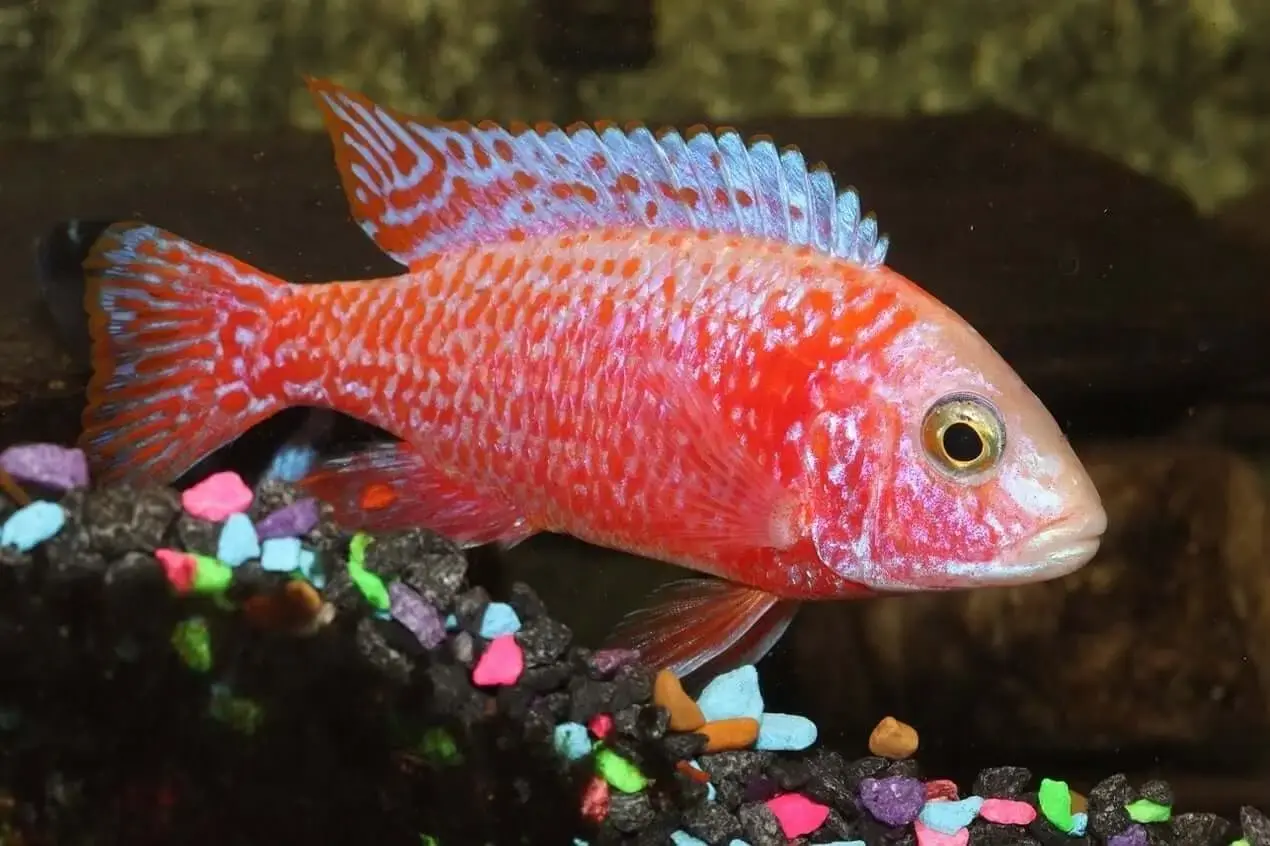
The Dragon Blood Peacock Cichlid is a stunning freshwater fish known for its fiery colors and semi-peaceful nature. This guide covers tank setup, diet, behavior, and everything you need to know to help your Dragon Blood thrive.
Quick Facts
- Scientific Name: Aulonocara hybrid
- Common Name: Dragon Blood Peacock Cichlid
- Origin: Bred variant (descended from Lake Malawi species)
- Adult Size: 5–6 inches
- Lifespan: 5–8 years
- Temperament: Semi-peaceful (can be territorial)
- Tank Size: Minimum 55 gallons
- Water Temperature: 76–82°F (24–28°C)
- pH Range: 7.6–8.6
- Diet: Omnivore
About the Dragon Blood Peacock Cichlid
The Dragon Blood Peacock Cichlid is a selectively bred strain of Aulonocara, not found in the wild. Unlike the more subdued natural colorations of many African cichlids, this hybrid boasts striking pink, red, and orange tones across its entire body.
While some purists shy away from hybrid strains, the Dragon Blood Peacock has earned popularity thanks to its color, relatively manageable temperament, and compatibility with other Malawi cichlids.
Ideal Tank Setup
Minimum Tank Size: 55 Gallons
These cichlids need space to roam and establish territory. A long tank is preferred over a tall one. If you plan on keeping multiple males or a mixed group, upgrade to 75+ gallons.
Substrate & Decor
- Substrate: Sand or fine gravel mimics their native habitat.
- Rocks & Caves: Use rock formations to create hiding places and break up lines of sight to reduce aggression.
- Plants: Hardy plants like Java fern or Anubias can be added but may be uprooted. Stick to anchored or floating plants if needed.
Filtration & Water Movement
Dragon Bloods are sensitive to poor water quality. Use a strong filter rated for your tank size, and consider adding powerheads for gentle water movement.
Water Parameters
| Parameter |
Ideal Range |
| Temperature |
76–82°F (24–28°C) |
| pH |
7.6–8.6 |
| Hardness (dGH) |
10–20 |
| Ammonia/Nitrite |
0 ppm |
| Nitrate |
< 20 ppm |
Perform regular 25–30% water changes weekly to maintain water quality.
Diet & Feeding
Dragon Blood Peacock Cichlids are omnivores, but they require a high-quality, low-filler diet to prevent bloat and digestive issues.
Recommended Foods:
- Pellets: Cichlid-specific sinking pellets with spirulina or color enhancers
- Frozen/Fresh: Bloodworms, brine shrimp, daphnia (as treats)
- Vegetables: Blanched spinach, zucchini, or peas
Note: Avoid high-protein or fatty foods like beef heart, and don’t overfeed—1–2 small feedings daily are ideal.
Tank Mates
While Dragon Blood Peacocks are more peaceful than Mbuna, they are still territorial, especially during breeding or in tight quarters.
Good Tank Mates:
- Other Peacock Cichlids (1 male to 3+ females)
- Haplochromis species
- Synodontis catfish
- Rainbowfish or larger peaceful barbs (if parameters match)
Avoid:
- Aggressive Mbuna (too combative)
- Small or slow-moving fish (may get bullied)
- Other male peacocks in small tanks
Tip: Always observe your tank’s dynamics and be ready to separate if aggression escalates.
Breeding Behavior
Breeding Dragon Blood Peacocks is similar to other mouthbrooding cichlids. Males display and court females, who then lay eggs and scoop them into their mouths. Females incubate the eggs for about 21 days before releasing free-swimming fry.
If you’re serious about breeding:
- Use a dedicated breeding tank
- Provide flat rocks or sandy pits for spawning
- Remove fry after release to prevent predation
Tips for Success
- Quarantine new fish before introducing them to your display tank.
- Avoid mixing males of similar appearance to reduce aggression.
- Use LED lighting to bring out their stunning coloration.
- Keep water stable—sudden shifts can cause stress and illness.
Common Health Issues
Like most African cichlids, Dragon Bloods are hardy when cared for properly. Still, be aware of:
- Malawi Bloat: Caused by stress, overfeeding, or poor diet
- Ich (White Spot): Treat promptly with heat and aquarium salt
- Hole-in-the-Head Disease: Linked to poor water quality and diet
Prevention is key: maintain water quality, avoid stressors, and feed a balanced diet.
Final Thoughts
The Dragon Blood Peacock Cichlid is more than just a pretty fish—it's a fascinating and interactive addition to a well-kept African cichlid tank. With the right setup, stable water conditions, and a balanced diet, your Dragon Blood will thrive and become a true centerpiece of your aquarium.